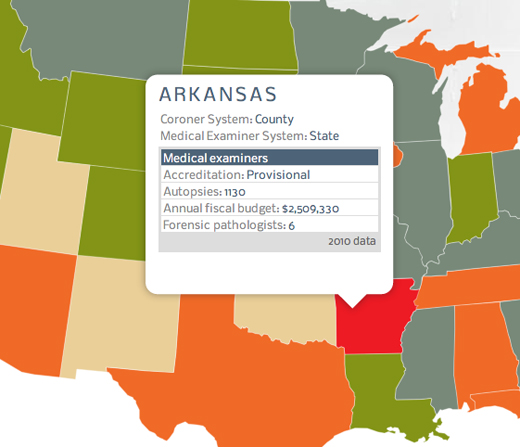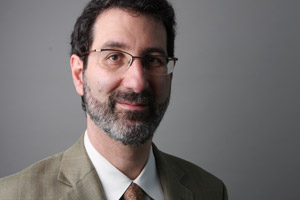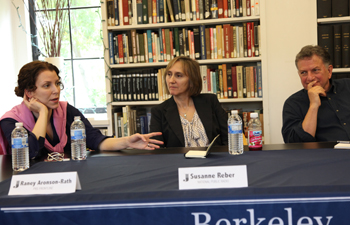Recently at the Logan Symposium at UC Berkeley’s Graduate School of Journalism, Mark Katches, California Watch’s editorial director, asked a room full of reporters and editors if anyone wanted to share a “collaboration horror story.” There were chuckles, but no volunteers. Horror story may have been too strong a term, but don’t be misled by the silence. The thing is, even though journalists spend their careers identifying systemic inefficiencies, shortcomings and vulnerabilities, I’ve recently learned that we aren’t as eager to discuss the cracks in our own field.
I spent months embedded in Post Mortem, the nearly year-long collaboration between Frontline, ProPublica and NPR, which exposed the dysfunctional patchwork of death investigation in America. The joint effort culminated in the most highly rated episode of Frontline’s season (a quantifiable plug for collaboration), a series of NPR stories and online and print pieces by ProPublica and California Watch, along with original data and interactive maps. Susanne Reber, NPR’s deputy managing editor of investigations who spearheaded many news partnerships at the CBC, called the effort an “unprecedented moment in journalism” in terms of the number of people involved and the amount of content produced. “Post Mortem” launched in February, but will rebroadcast tonight on Frontline. Here’s the first part of the special:
Watch the full episode. See more FRONTLINE.
Documenting a Collaboration Up Close
Why embed a reporter in “Post Mortem?” The idea was to have someone document and attempt to understand the intricacies of collaborative reporting: how it works, how it doesn’t work and why it’s worth doing, even as it presents new hurdles to an already complicated affair. This was the brainchild of Lowell Bergman (my boss), a veteran investigative reporter and Frontline producer and correspondent, who partnered with news organizations long before it was in vogue. He is now the Reva and David Logan Distinguished Professor of Investigative Reporting at the Graduate School of Journalism, where he founded the program.
Back in 2002, Bergman’s Pulitzer Prize-winning series A Dangerous Business was a joint investigation between Frontline, the New York Times and the CBC. Co-written with David Barstow, the series revealed the shocking, at times deadly, business practices of the McWane Corporation. The media partnership was an anomaly, but the New York Times was interested in producing long-form television at the time. As Bergman tells it, it was clear by then that print was no longer going to be enough.
The scheduled publication and broadcast date for “A Dangerous Business” was November 2002. “But in early October,” recalls Bergman, “I was stopped at the side of the road between Tyler, Texas and Dallas, and the editors at the New York Times were telling me that they couldn’t get it edited before the first week of December.” There went the November launch, which was ultimately pushed back to January.
Another memorable moment was when the CBC changed the title of its broadcast from “A Dangerous Business” to “A Toxic Company,” and issued a press release before notifying Frontline or the Times of the change. The new title garnered a letter threatening a lawsuit that never materialized, but the team was prepared for the worst.
This is the stuff of collaboration: the actions of one media organization, behaving in a business-as-usual fashion, and most likely, in the best interest of the story and its audience, have a ripple effect on its partners. After all, even if you’re working as a team, you need to uphold your own organizational and storytelling demands.
Not Business as Usual
But if there’s one thing I learned watching “Post Mortem” unfold, it’s that collaborations are not business as usual. That’s what makes them exciting, promising and a little messy.
Collaboration has been a buzzword for several years, emerging from the confluence of new technologies and economic hardship within the industry. Media upstarts and nonprofits, who are more flexible than old media, have been at the forefront of experimenting with new reporting and publication models. And organizations are partnering so frequently that Investigative Reporters and Editors (IRE) Contest added a new Partnership/Collaboration category to its list of awards. But it’s perhaps most telling that legacy media organizations are regularly working together, sharing stories instead of competing to break them.

Back in October, Raney Aronson-Rath, Frontline’s senior producer, estimated that a third of their projects are collaborations. That’s a shift from the way they’ve worked historically, and it reflects sweeping changes in the industry overall: technically, logistically, philosophically and culturally. And other organizations are following suit. Last week, the Associated Press announced that it would begin distributing news generated by several nonprofits.
In Frontline’s case, Aronson-Rath says that working with others is about the journalism and the cross-platform possibilities.
“One of our ideal relationships is with ProPublica,” she explained. “They are generating real investigative reporting. We want Frontline films to be infused with investigative reporting, but can’t always afford the resources to generate the digging, so in this way, we share resources.”
Once you get NPR into the mix, as they did with “Post Mortem,” you get the added value of reaching millions of listeners.
Steep Learning Curve
In the big picture, everybody wins. The audience included. And in the networked world it makes sense to work together to improve the journalism, to reach more people and to capitalize on the skills and talents of colleagues. Which is why collaboration is here to stay. But there’s a learning curve to working this way as basic issues pose challenges, from how to communicate to how to share information to how to simultaneously report for different platforms. Trying to understand how it all works can be confusing, even with a front-row view, so imagine what it’s like when you’re truly in it.

“Chaos is the ultimate form of investigative reporting,” Stephen Engelberg, managing editor of ProPublica, told me in the midst of “Post Mortem.” “You have to acknowledge that inefficiency is part of the process.” He was explaining the vicissitudes of an investigative piece, where a story can take unexpected turns all the way down to the wire. Joint reporting is not so different.
At the most basic level, think about the logistics. With “Post Mortem” it was often a struggle to get everyone in the same room. At times, there would be 15 busy, bicoastal people on a conference call. It was always a juggle keeping everyone in the loop, but with that many people, I’m certain there were some who wouldn’t have minded being excluded.
The reality is that collaborations take different forms (sometimes resembling syndication more than teamwork), so many scenarios can’t be foreseen. The workflow is necessarily a function of the organizations, the platforms and the stories themselves. But variables aside, there are logistical, reporting and editorial issues that can and should be addressed up front. Among them are questions like: What’s the story? Who is telling what story? Will the same story be replicated across platforms, or will they be distinct? And can each platform get the material it needs to make it all worth it?
These are the points that Bergman raised with the Knight Foundation when he asked them to fund “Collective Work,” an Investigative Reporting Program project to help identify best practices for collaborative investigative reporting. In the coming months, here on MediaShift, we’ll begin sharing some of what we’ve learned and reporting on the experiences of others. The hope is that someday reporters and editors won’t nervously hide their collaboration war stories — not because they won’t exist, but because some of the challenges will be mitigated or at least anticipated when we begin discussing them.
Carrie Lozano is a Bay-Area based documentary filmmaker and journalist. Among other work, she produced the Academy Award nominee The Weather Underground and the recent live-performance documentary Utopia in Four Movements. She also produced and directed the award-winning film Reporter Zero. She graduated from Berkeley’s Graduate School of Journalism in 2005, where she studied with filmmaker Jon Else. In 2008, she received a post-graduate fellowship with Lowell Bergman’s Investigative Reporting Project where she reported on PBS Frontline’s “Black Money.” She is currently directing a Knight-funded project about collaborative, multi-platform investigative reporting at the Investigative Reporting Program and is directing and producing a documentary film with Charlotte Lagarde about composer Fred Hersch.

